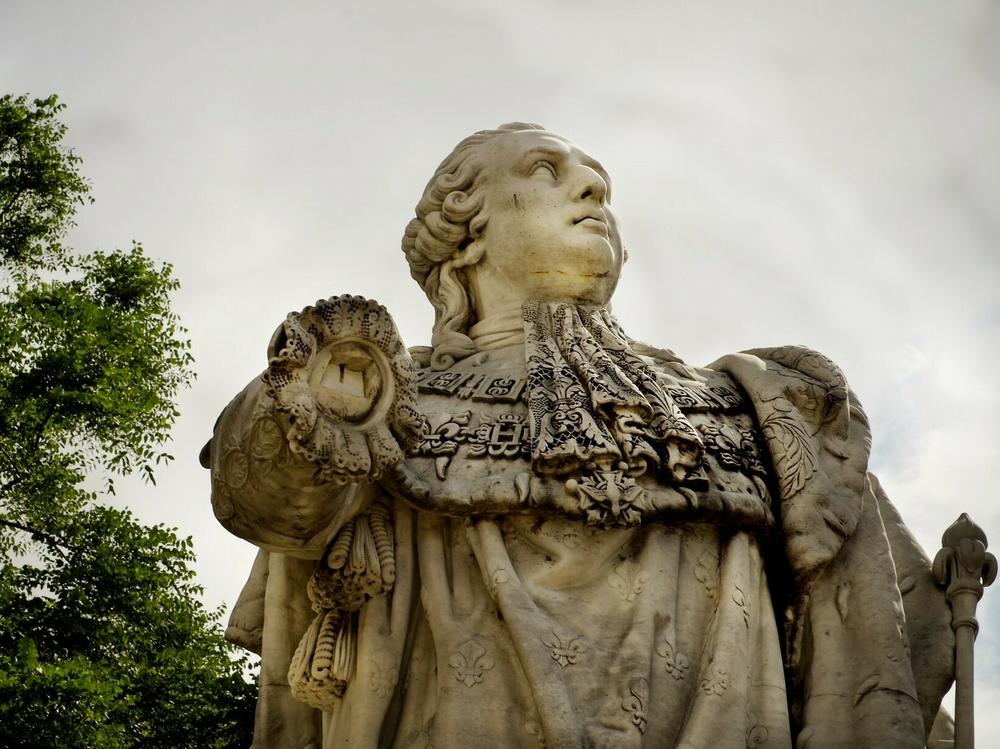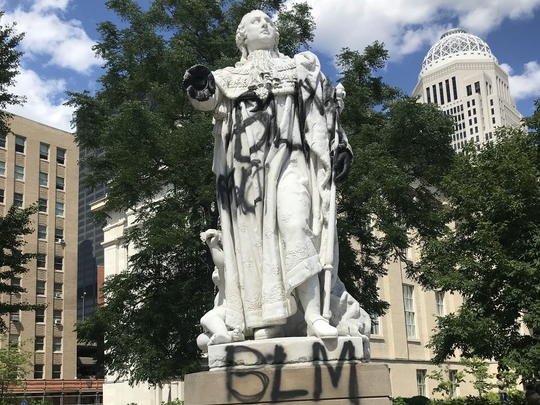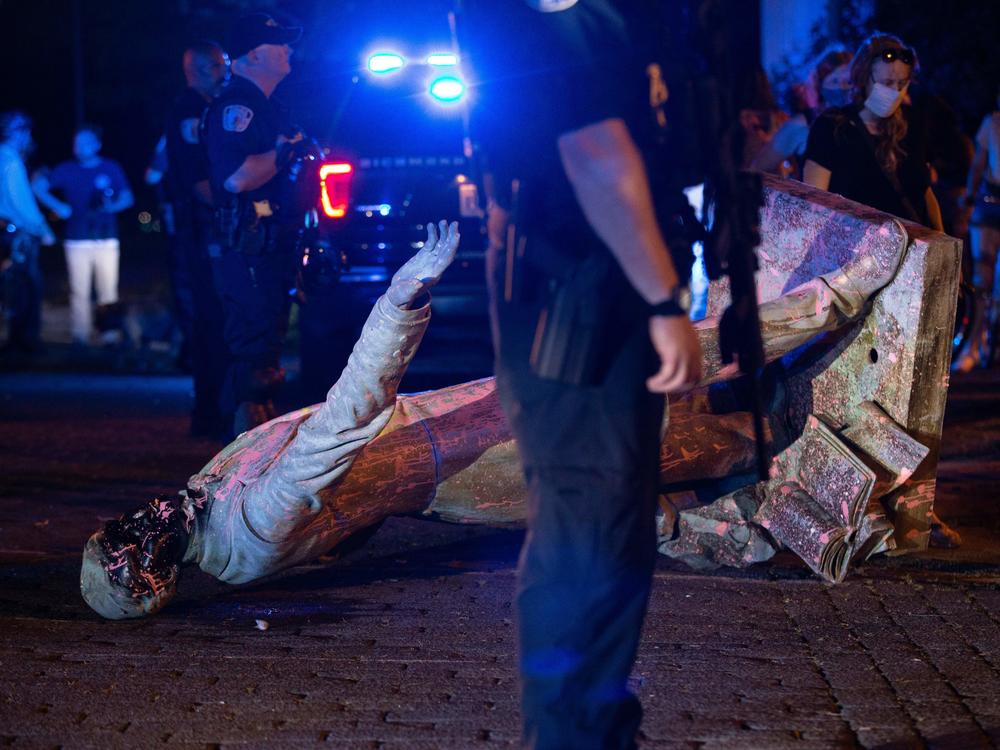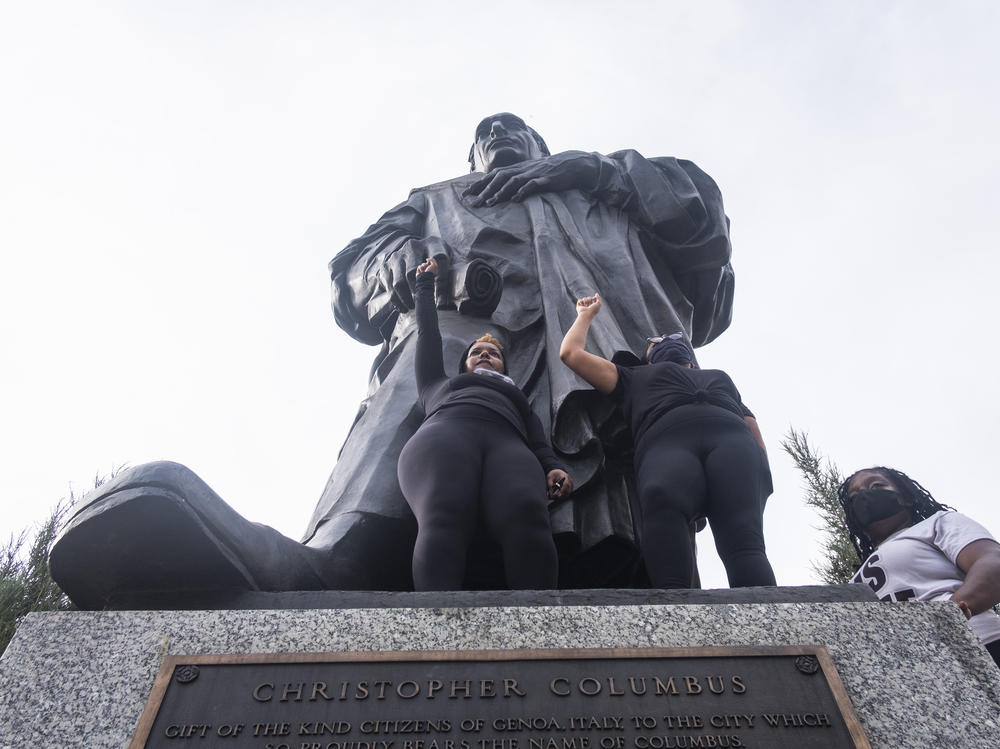Section Branding
Header Content
Removed during protests, Louisville's statue of King Louis XVI is still in limbo
Primary Content
Local leaders in Louisville, Ky. are trying to figure out what to do with a statue of its namesake, King Louis XVI of France, nearly four years after it was moved into storage.
The 200-year-old statue was damaged during protests over the police killing of Breonna Taylor in 2020. Protests broke out across the country that summer, forcing local governments to address long-standing racial disparities and police misconduct. It also caused them to rethink controversial monuments.
Jessica Bennett Kincaid, Louisville's public art administrator, said the city has no plans to put King Louis back on display, for now.
"I think I think that some might assume that we're sort of stalling, but we just don't have an obvious solution at this point," she said.
How we got here
On May 28, 2020, protesters gathered in front of Louisville Metro Hall after the city released the gut-wrenching 911 calls from Taylor's boyfriend and neighbors after the shooting.
As the demonstration swelled, one man got up onto the plinth where a 9-ton marble statue of King Louis XVI had stood since the 1960's. Then the man, and Louis' marble hand, fell into the crowd.
The statue remained on display throughout the summer, handless and covered in graffiti. The city eventually took it down, citing public safety concerns.
An analysis by three conservation firms found damage dating back much further than 2020. The statue — commissioned by King Louis XVI's daughter after his execution during the French revolution — was moved multiple times after it was first displayed in 1830.
"The stone material has veining in it and some of those veins can release over time," Kincaid explained. "The more you move such a heavy object, the more likely it is to have those veins release."
Montpellier, France gifted the statue to its sister city Louisville in 1966. Since then, Kincaid said the freeze-thaw cycle of the Ohio River Valley hasn't been kind to the monarch's likeness.
"If something is a porous material, water and moisture can seep into it and, of course, when it freezes, it expands," she said.
Kincaid said part of the reason the statue to Louisville's namesake hasn't been put back on display is the price tag. Repairs have been estimated at around $200,000.
But, like other communities across the country, the city has also spent the last three years grappling with what their public art represents.
A survey conducted by Louisville in 2022 found 40% of respondents didn't think the 18th Century monarch represents their values. Some of them noted Louis' connection to colonialism and resistance to democracy at home.
Some who want the statue restored, like Republican Metro Councilman Kevin Kramer, said it symbolizes what the city's founders believed: that France's support was instrumental to the American Revolution.
"If it hadn't been for the French willingness to be involved in this, if it hadn't been for the distraction [they created], I don't know how you overlook the significance of that," Kramer said.
Ninety percent of the people who responded to the city's survey agreed with Kramer, saying they want the statue put back on display. But they differed on what that would look like.
"Same spot but minus his head. For historical accuracy," one person responded. Others said the damage and graffiti should stay, as a symbol of the 2020 protests.
Lessons from near and far
Many of the conservators contracted by the city initially declined to do any preservation work until officials conducted a comprehensive public engagement process. That's because in 2020, the American Institute of Conservation put out a position paper urging cities and preservationists to think more critically about what it called "contested monuments."
Katherine Ridgway, a conservator at the Virginia Department of Historic Resources, was one of the authors of that paper. She said the goal was to lay out a process for how cities can work with communities when deciding what to do with controversial statues.
She said leaving monuments graffitied and damaged, as some survey respondents in Louisville suggested, can be the right decision for some cities.
"The goal with this was to make a definition between vandalism that is for damage's sake, and the idea that there is graffiti and vandalism that has to do with social justice movements," Ridgway said. "That is absolutely part of our history now."
A handful of Confederate statues in Richmond, Va. were removed in 2020. One such statue, which depicts Confederate President Jefferson Davis, is on display at a local history museum dented and covered in graffiti, the same condition as when it was toppled.
Just a three hour drive from Louisville, in Columbus, Ohio, residents and city officials have spent the last three years debating a statue to their own namesake: explorer Christopher Columbus.
Like Louisville, Columbus removed its monument from the front of city hall in 2020. But the city recently received a grant from the Mellon Foundation to explore what contextualizing the statue might look like.
Jennifer Fening, deputy director of the city's department of development, said they've hired a Native-American-led design firm to help tell a more nuanced story about Columbus, the historical figure, and Columbus, the community.
"We hope to design a space where the statute can be used to tell the stories of people who haven't felt seen and celebrated in our city, and to articulate who we are as a community today, in light of our namesake," Fening said.
Columbus will hold multiple public meetings in the coming year that will center the communities with the biggest stake in the conversation: Italian-American and Native-American residents.
Indigenous activist Shelly Corbin was part of a previous advisory committee on the Columbus statue. Corbin, a member of the Cheyenne River Sioux Tribe, said she thinks the Reimagining Columbus project could help the city find consensus not just on the statue, but on other important issues.
"If we can ultimately be successful with this movement, how much more engagement and really creating a community-centered Columbus could that do, in terms of shifting narratives, in terms of building bridges?" she said.
The City of Columbus has set aside $3.5 million for the project, including $1.5 million for the creation of new public artworks.
Where does Louisville go from here?
The King Louis statue's future is less clear in Louisville. Efforts to find a new home where residents and visitors could admire the centuries old sculpture, are at a standstill.
Conservation firms have advised the city that the statue not be placed outdoors again for fear of further damage by the elements.
Kincaid, Louisville's public art administrator, said the city recently reached out to local museums to talk about taking King Louis on loan, but so far there's been little interest. She said most just don't have a place to display a 9-ton statue.
"It can't just be put into any building," she said. "There would have to be structural support, reinforcement of floors, having an access point large enough to get the sculpture through the door."
For now, city officials say they've exhausted all options.
Kincaid said discussions have moved on to what should take King Louis's place outside city hall and, perhaps more importantly, how permanent this new piece should be.
"Most public art programs are a little cautious to turn around and replace these statues with something else very permanent while we're still navigating that conversation that precipitated the removal of all these monuments in the first place," Kincaid said.
City officials hope to find a new namesake, of sorts – something that can represent the community and its values in the present day.




